LEGAL420-18B Employment Law Essay: Key Legal Principles
VerifiedAdded on 2023/06/08
|10
|2912
|277
Essay
AI Summary
This essay delves into key aspects of Employment Law, primarily focusing on the Employment Relations Act 2000 in New Zealand. It examines the process of unjustified dismissal, outlining the rights of employees to bring personal grievances and the burden of proof on employers to justify dismissals. The essay also explores issues of workplace harassment, including sexual and racial harassment, and details the requirements for internal investigations and the application of the test of justification by the Employment Relations Authority and the courts. Furthermore, it analyses employer liability for the actions of co-workers and the importance of good faith in employment relationships, emphasizing the role of communication and investigation in addressing complaints. The essay references relevant sections of the Employment Relations Act 2000 and provides case law examples to illustrate the legal principles discussed, including the application of the justification test in cases of employee dismissal or harassment.
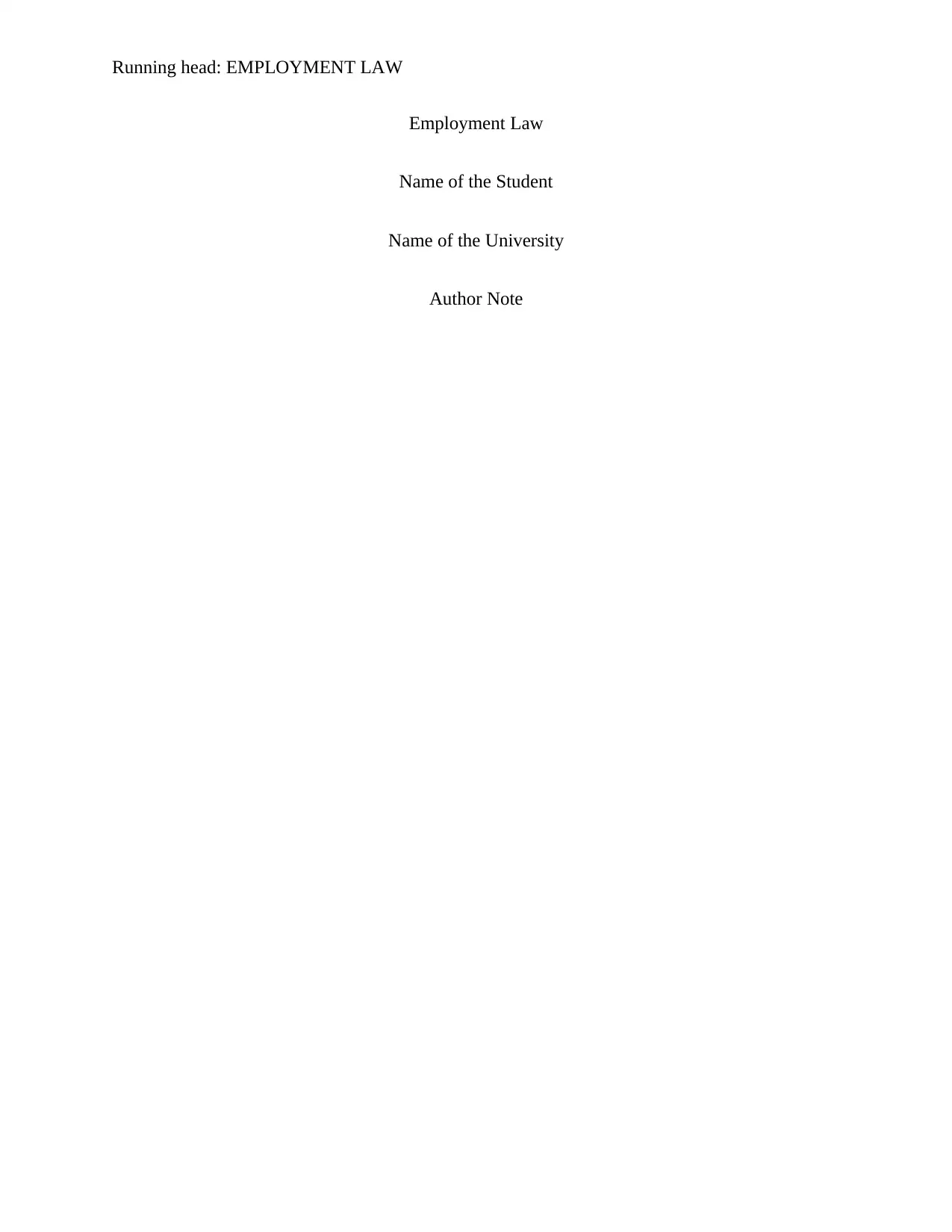
Running head: EMPLOYMENT LAW
Employment Law
Name of the Student
Name of the University
Author Note
Employment Law
Name of the Student
Name of the University
Author Note
Paraphrase This Document
Need a fresh take? Get an instant paraphrase of this document with our AI Paraphraser
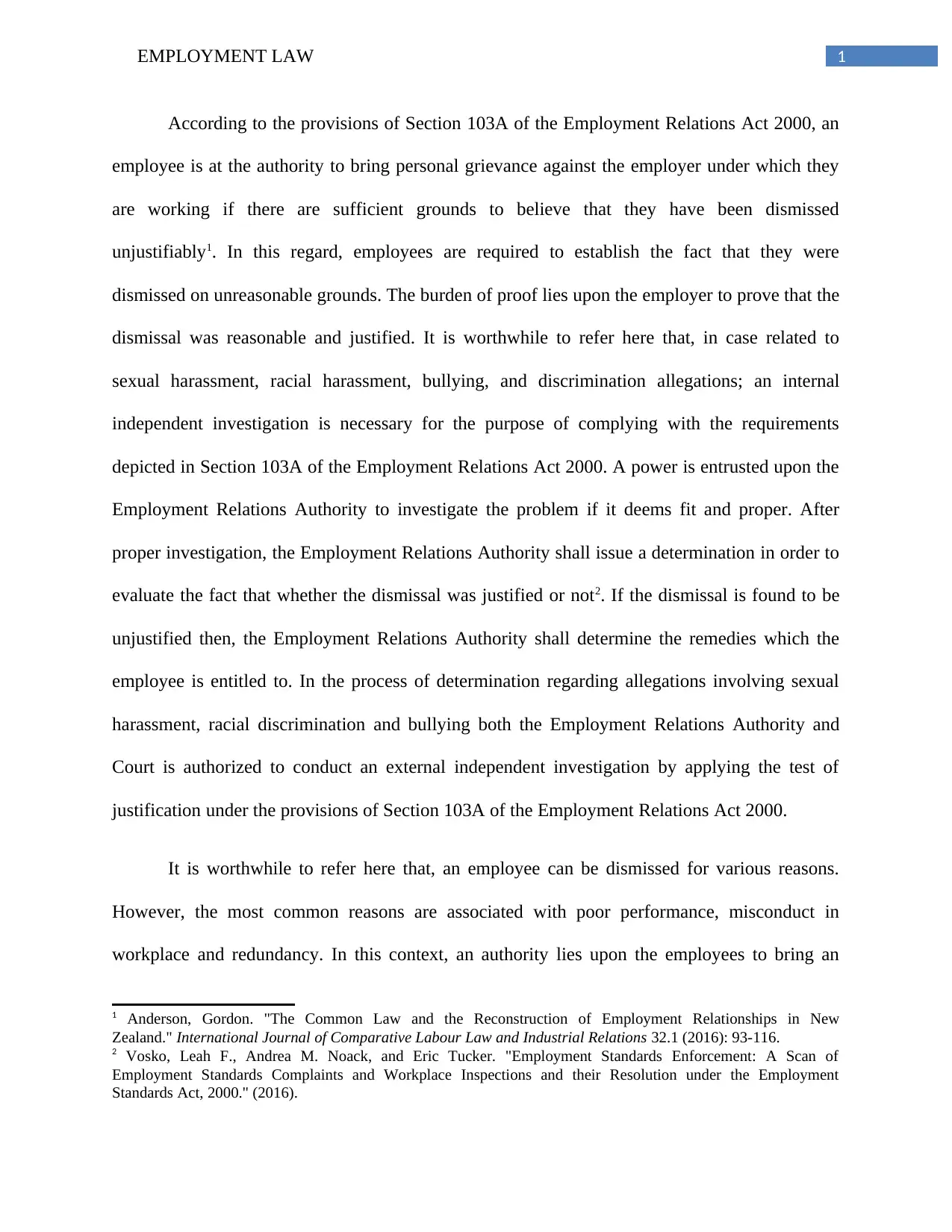
1EMPLOYMENT LAW
According to the provisions of Section 103A of the Employment Relations Act 2000, an
employee is at the authority to bring personal grievance against the employer under which they
are working if there are sufficient grounds to believe that they have been dismissed
unjustifiably1. In this regard, employees are required to establish the fact that they were
dismissed on unreasonable grounds. The burden of proof lies upon the employer to prove that the
dismissal was reasonable and justified. It is worthwhile to refer here that, in case related to
sexual harassment, racial harassment, bullying, and discrimination allegations; an internal
independent investigation is necessary for the purpose of complying with the requirements
depicted in Section 103A of the Employment Relations Act 2000. A power is entrusted upon the
Employment Relations Authority to investigate the problem if it deems fit and proper. After
proper investigation, the Employment Relations Authority shall issue a determination in order to
evaluate the fact that whether the dismissal was justified or not2. If the dismissal is found to be
unjustified then, the Employment Relations Authority shall determine the remedies which the
employee is entitled to. In the process of determination regarding allegations involving sexual
harassment, racial discrimination and bullying both the Employment Relations Authority and
Court is authorized to conduct an external independent investigation by applying the test of
justification under the provisions of Section 103A of the Employment Relations Act 2000.
It is worthwhile to refer here that, an employee can be dismissed for various reasons.
However, the most common reasons are associated with poor performance, misconduct in
workplace and redundancy. In this context, an authority lies upon the employees to bring an
1 Anderson, Gordon. "The Common Law and the Reconstruction of Employment Relationships in New
Zealand." International Journal of Comparative Labour Law and Industrial Relations 32.1 (2016): 93-116.
2 Vosko, Leah F., Andrea M. Noack, and Eric Tucker. "Employment Standards Enforcement: A Scan of
Employment Standards Complaints and Workplace Inspections and their Resolution under the Employment
Standards Act, 2000." (2016).
According to the provisions of Section 103A of the Employment Relations Act 2000, an
employee is at the authority to bring personal grievance against the employer under which they
are working if there are sufficient grounds to believe that they have been dismissed
unjustifiably1. In this regard, employees are required to establish the fact that they were
dismissed on unreasonable grounds. The burden of proof lies upon the employer to prove that the
dismissal was reasonable and justified. It is worthwhile to refer here that, in case related to
sexual harassment, racial harassment, bullying, and discrimination allegations; an internal
independent investigation is necessary for the purpose of complying with the requirements
depicted in Section 103A of the Employment Relations Act 2000. A power is entrusted upon the
Employment Relations Authority to investigate the problem if it deems fit and proper. After
proper investigation, the Employment Relations Authority shall issue a determination in order to
evaluate the fact that whether the dismissal was justified or not2. If the dismissal is found to be
unjustified then, the Employment Relations Authority shall determine the remedies which the
employee is entitled to. In the process of determination regarding allegations involving sexual
harassment, racial discrimination and bullying both the Employment Relations Authority and
Court is authorized to conduct an external independent investigation by applying the test of
justification under the provisions of Section 103A of the Employment Relations Act 2000.
It is worthwhile to refer here that, an employee can be dismissed for various reasons.
However, the most common reasons are associated with poor performance, misconduct in
workplace and redundancy. In this context, an authority lies upon the employees to bring an
1 Anderson, Gordon. "The Common Law and the Reconstruction of Employment Relationships in New
Zealand." International Journal of Comparative Labour Law and Industrial Relations 32.1 (2016): 93-116.
2 Vosko, Leah F., Andrea M. Noack, and Eric Tucker. "Employment Standards Enforcement: A Scan of
Employment Standards Complaints and Workplace Inspections and their Resolution under the Employment
Standards Act, 2000." (2016).
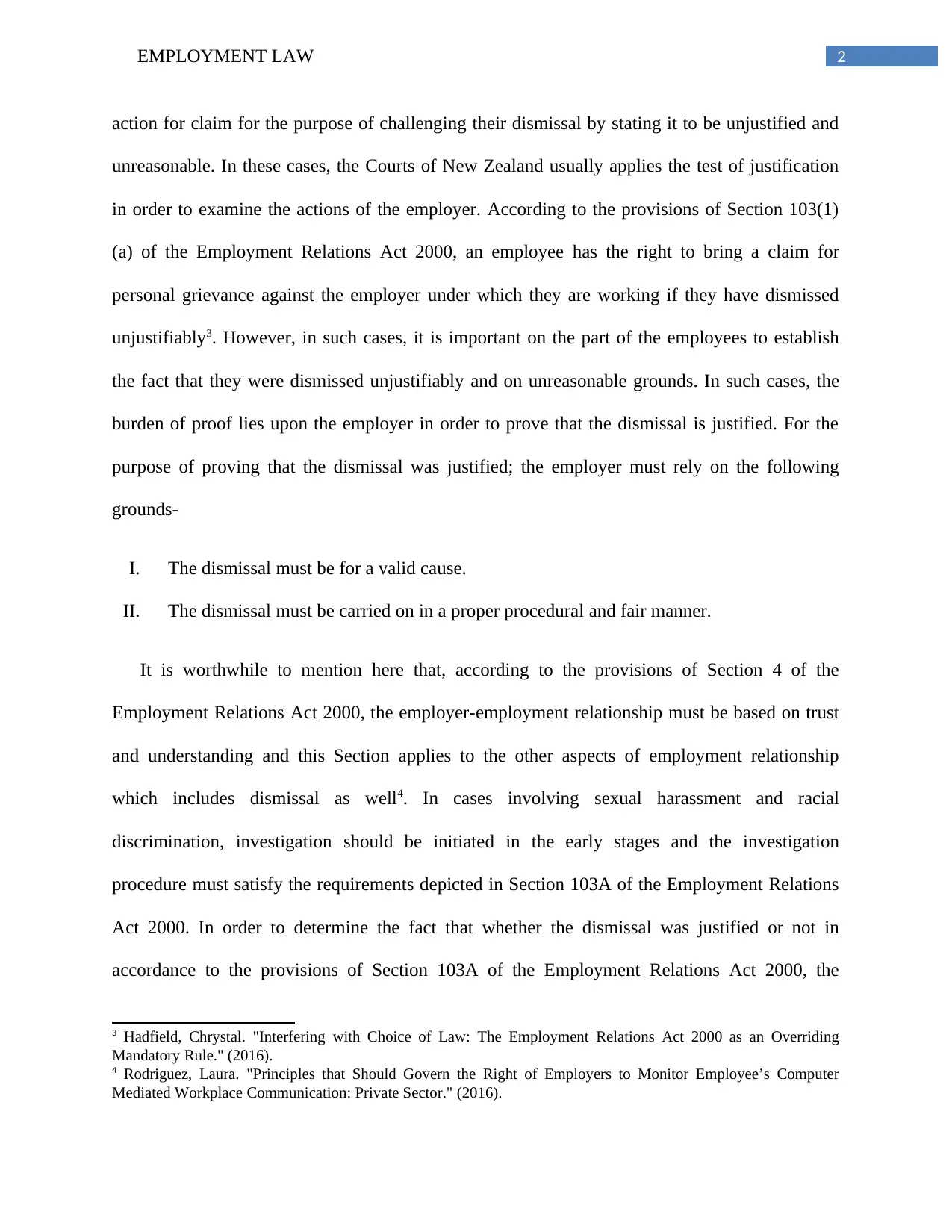
2EMPLOYMENT LAW
action for claim for the purpose of challenging their dismissal by stating it to be unjustified and
unreasonable. In these cases, the Courts of New Zealand usually applies the test of justification
in order to examine the actions of the employer. According to the provisions of Section 103(1)
(a) of the Employment Relations Act 2000, an employee has the right to bring a claim for
personal grievance against the employer under which they are working if they have dismissed
unjustifiably3. However, in such cases, it is important on the part of the employees to establish
the fact that they were dismissed unjustifiably and on unreasonable grounds. In such cases, the
burden of proof lies upon the employer in order to prove that the dismissal is justified. For the
purpose of proving that the dismissal was justified; the employer must rely on the following
grounds-
I. The dismissal must be for a valid cause.
II. The dismissal must be carried on in a proper procedural and fair manner.
It is worthwhile to mention here that, according to the provisions of Section 4 of the
Employment Relations Act 2000, the employer-employment relationship must be based on trust
and understanding and this Section applies to the other aspects of employment relationship
which includes dismissal as well4. In cases involving sexual harassment and racial
discrimination, investigation should be initiated in the early stages and the investigation
procedure must satisfy the requirements depicted in Section 103A of the Employment Relations
Act 2000. In order to determine the fact that whether the dismissal was justified or not in
accordance to the provisions of Section 103A of the Employment Relations Act 2000, the
3 Hadfield, Chrystal. "Interfering with Choice of Law: The Employment Relations Act 2000 as an Overriding
Mandatory Rule." (2016).
4 Rodriguez, Laura. "Principles that Should Govern the Right of Employers to Monitor Employee’s Computer
Mediated Workplace Communication: Private Sector." (2016).
action for claim for the purpose of challenging their dismissal by stating it to be unjustified and
unreasonable. In these cases, the Courts of New Zealand usually applies the test of justification
in order to examine the actions of the employer. According to the provisions of Section 103(1)
(a) of the Employment Relations Act 2000, an employee has the right to bring a claim for
personal grievance against the employer under which they are working if they have dismissed
unjustifiably3. However, in such cases, it is important on the part of the employees to establish
the fact that they were dismissed unjustifiably and on unreasonable grounds. In such cases, the
burden of proof lies upon the employer in order to prove that the dismissal is justified. For the
purpose of proving that the dismissal was justified; the employer must rely on the following
grounds-
I. The dismissal must be for a valid cause.
II. The dismissal must be carried on in a proper procedural and fair manner.
It is worthwhile to mention here that, according to the provisions of Section 4 of the
Employment Relations Act 2000, the employer-employment relationship must be based on trust
and understanding and this Section applies to the other aspects of employment relationship
which includes dismissal as well4. In cases involving sexual harassment and racial
discrimination, investigation should be initiated in the early stages and the investigation
procedure must satisfy the requirements depicted in Section 103A of the Employment Relations
Act 2000. In order to determine the fact that whether the dismissal was justified or not in
accordance to the provisions of Section 103A of the Employment Relations Act 2000, the
3 Hadfield, Chrystal. "Interfering with Choice of Law: The Employment Relations Act 2000 as an Overriding
Mandatory Rule." (2016).
4 Rodriguez, Laura. "Principles that Should Govern the Right of Employers to Monitor Employee’s Computer
Mediated Workplace Communication: Private Sector." (2016).
⊘ This is a preview!⊘
Do you want full access?
Subscribe today to unlock all pages.

Trusted by 1+ million students worldwide
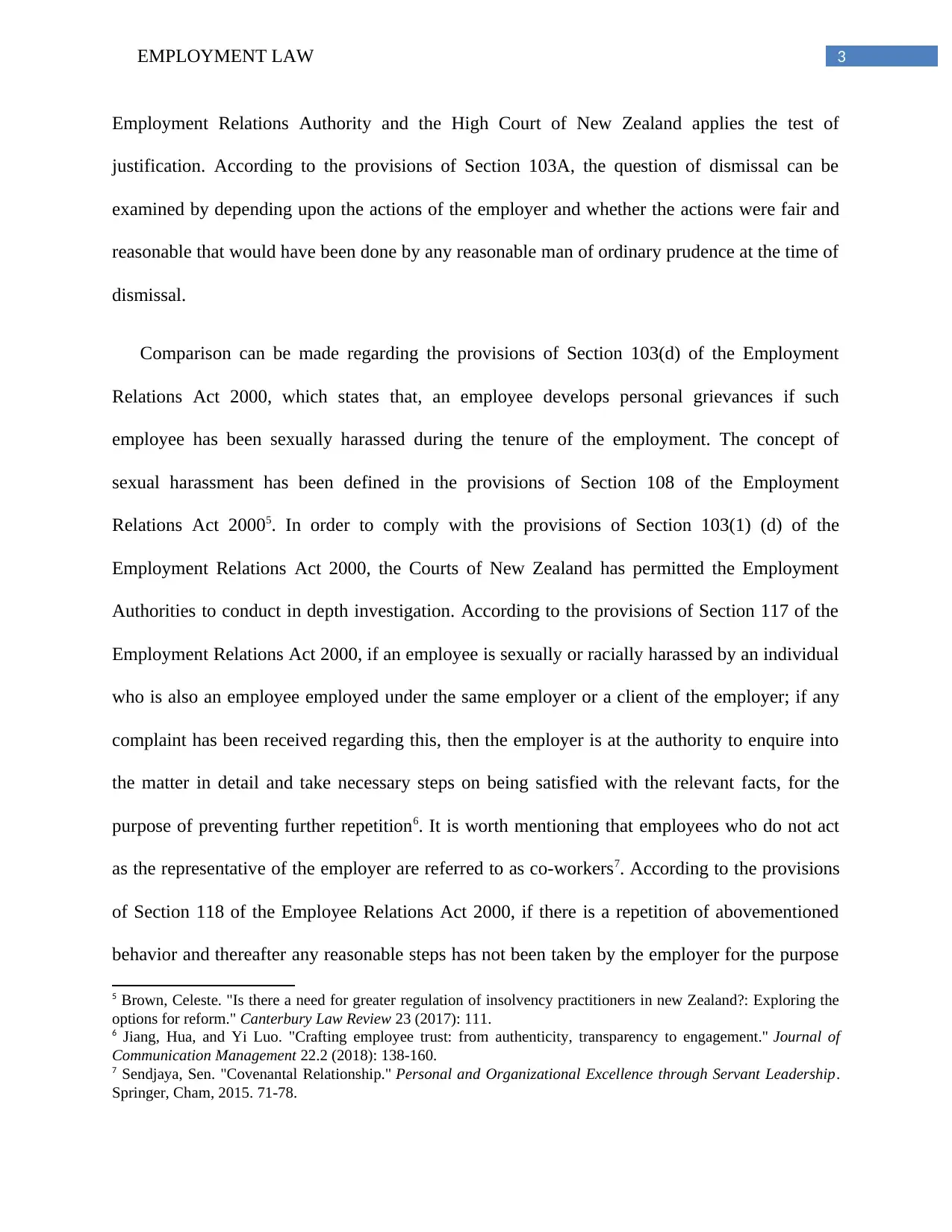
3EMPLOYMENT LAW
Employment Relations Authority and the High Court of New Zealand applies the test of
justification. According to the provisions of Section 103A, the question of dismissal can be
examined by depending upon the actions of the employer and whether the actions were fair and
reasonable that would have been done by any reasonable man of ordinary prudence at the time of
dismissal.
Comparison can be made regarding the provisions of Section 103(d) of the Employment
Relations Act 2000, which states that, an employee develops personal grievances if such
employee has been sexually harassed during the tenure of the employment. The concept of
sexual harassment has been defined in the provisions of Section 108 of the Employment
Relations Act 20005. In order to comply with the provisions of Section 103(1) (d) of the
Employment Relations Act 2000, the Courts of New Zealand has permitted the Employment
Authorities to conduct in depth investigation. According to the provisions of Section 117 of the
Employment Relations Act 2000, if an employee is sexually or racially harassed by an individual
who is also an employee employed under the same employer or a client of the employer; if any
complaint has been received regarding this, then the employer is at the authority to enquire into
the matter in detail and take necessary steps on being satisfied with the relevant facts, for the
purpose of preventing further repetition6. It is worth mentioning that employees who do not act
as the representative of the employer are referred to as co-workers7. According to the provisions
of Section 118 of the Employee Relations Act 2000, if there is a repetition of abovementioned
behavior and thereafter any reasonable steps has not been taken by the employer for the purpose
5 Brown, Celeste. "Is there a need for greater regulation of insolvency practitioners in new Zealand?: Exploring the
options for reform." Canterbury Law Review 23 (2017): 111.
6 Jiang, Hua, and Yi Luo. "Crafting employee trust: from authenticity, transparency to engagement." Journal of
Communication Management 22.2 (2018): 138-160.
7 Sendjaya, Sen. "Covenantal Relationship." Personal and Organizational Excellence through Servant Leadership.
Springer, Cham, 2015. 71-78.
Employment Relations Authority and the High Court of New Zealand applies the test of
justification. According to the provisions of Section 103A, the question of dismissal can be
examined by depending upon the actions of the employer and whether the actions were fair and
reasonable that would have been done by any reasonable man of ordinary prudence at the time of
dismissal.
Comparison can be made regarding the provisions of Section 103(d) of the Employment
Relations Act 2000, which states that, an employee develops personal grievances if such
employee has been sexually harassed during the tenure of the employment. The concept of
sexual harassment has been defined in the provisions of Section 108 of the Employment
Relations Act 20005. In order to comply with the provisions of Section 103(1) (d) of the
Employment Relations Act 2000, the Courts of New Zealand has permitted the Employment
Authorities to conduct in depth investigation. According to the provisions of Section 117 of the
Employment Relations Act 2000, if an employee is sexually or racially harassed by an individual
who is also an employee employed under the same employer or a client of the employer; if any
complaint has been received regarding this, then the employer is at the authority to enquire into
the matter in detail and take necessary steps on being satisfied with the relevant facts, for the
purpose of preventing further repetition6. It is worth mentioning that employees who do not act
as the representative of the employer are referred to as co-workers7. According to the provisions
of Section 118 of the Employee Relations Act 2000, if there is a repetition of abovementioned
behavior and thereafter any reasonable steps has not been taken by the employer for the purpose
5 Brown, Celeste. "Is there a need for greater regulation of insolvency practitioners in new Zealand?: Exploring the
options for reform." Canterbury Law Review 23 (2017): 111.
6 Jiang, Hua, and Yi Luo. "Crafting employee trust: from authenticity, transparency to engagement." Journal of
Communication Management 22.2 (2018): 138-160.
7 Sendjaya, Sen. "Covenantal Relationship." Personal and Organizational Excellence through Servant Leadership.
Springer, Cham, 2015. 71-78.
Paraphrase This Document
Need a fresh take? Get an instant paraphrase of this document with our AI Paraphraser
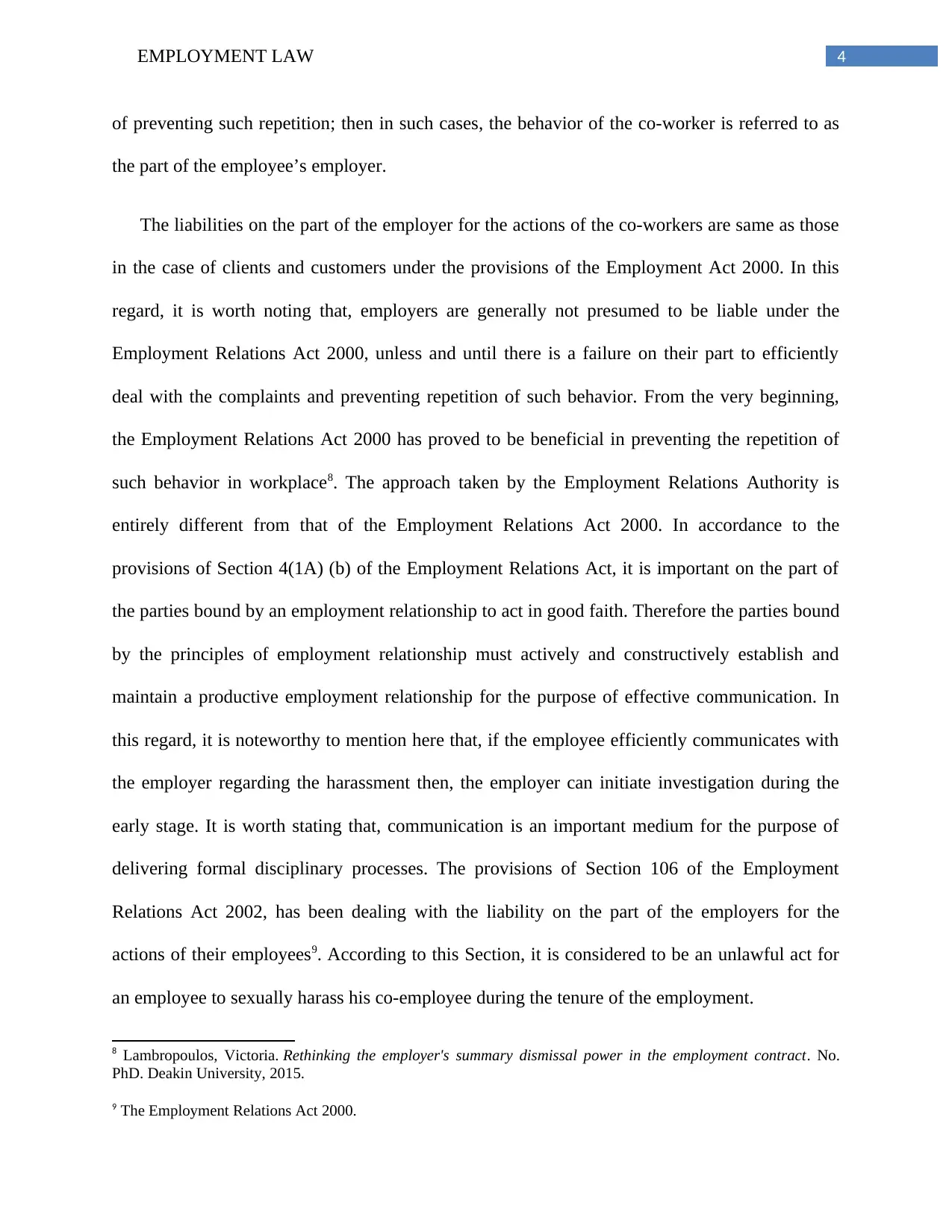
4EMPLOYMENT LAW
of preventing such repetition; then in such cases, the behavior of the co-worker is referred to as
the part of the employee’s employer.
The liabilities on the part of the employer for the actions of the co-workers are same as those
in the case of clients and customers under the provisions of the Employment Act 2000. In this
regard, it is worth noting that, employers are generally not presumed to be liable under the
Employment Relations Act 2000, unless and until there is a failure on their part to efficiently
deal with the complaints and preventing repetition of such behavior. From the very beginning,
the Employment Relations Act 2000 has proved to be beneficial in preventing the repetition of
such behavior in workplace8. The approach taken by the Employment Relations Authority is
entirely different from that of the Employment Relations Act 2000. In accordance to the
provisions of Section 4(1A) (b) of the Employment Relations Act, it is important on the part of
the parties bound by an employment relationship to act in good faith. Therefore the parties bound
by the principles of employment relationship must actively and constructively establish and
maintain a productive employment relationship for the purpose of effective communication. In
this regard, it is noteworthy to mention here that, if the employee efficiently communicates with
the employer regarding the harassment then, the employer can initiate investigation during the
early stage. It is worth stating that, communication is an important medium for the purpose of
delivering formal disciplinary processes. The provisions of Section 106 of the Employment
Relations Act 2002, has been dealing with the liability on the part of the employers for the
actions of their employees9. According to this Section, it is considered to be an unlawful act for
an employee to sexually harass his co-employee during the tenure of the employment.
8 Lambropoulos, Victoria. Rethinking the employer's summary dismissal power in the employment contract. No.
PhD. Deakin University, 2015.
9 The Employment Relations Act 2000.
of preventing such repetition; then in such cases, the behavior of the co-worker is referred to as
the part of the employee’s employer.
The liabilities on the part of the employer for the actions of the co-workers are same as those
in the case of clients and customers under the provisions of the Employment Act 2000. In this
regard, it is worth noting that, employers are generally not presumed to be liable under the
Employment Relations Act 2000, unless and until there is a failure on their part to efficiently
deal with the complaints and preventing repetition of such behavior. From the very beginning,
the Employment Relations Act 2000 has proved to be beneficial in preventing the repetition of
such behavior in workplace8. The approach taken by the Employment Relations Authority is
entirely different from that of the Employment Relations Act 2000. In accordance to the
provisions of Section 4(1A) (b) of the Employment Relations Act, it is important on the part of
the parties bound by an employment relationship to act in good faith. Therefore the parties bound
by the principles of employment relationship must actively and constructively establish and
maintain a productive employment relationship for the purpose of effective communication. In
this regard, it is noteworthy to mention here that, if the employee efficiently communicates with
the employer regarding the harassment then, the employer can initiate investigation during the
early stage. It is worth stating that, communication is an important medium for the purpose of
delivering formal disciplinary processes. The provisions of Section 106 of the Employment
Relations Act 2002, has been dealing with the liability on the part of the employers for the
actions of their employees9. According to this Section, it is considered to be an unlawful act for
an employee to sexually harass his co-employee during the tenure of the employment.
8 Lambropoulos, Victoria. Rethinking the employer's summary dismissal power in the employment contract. No.
PhD. Deakin University, 2015.
9 The Employment Relations Act 2000.
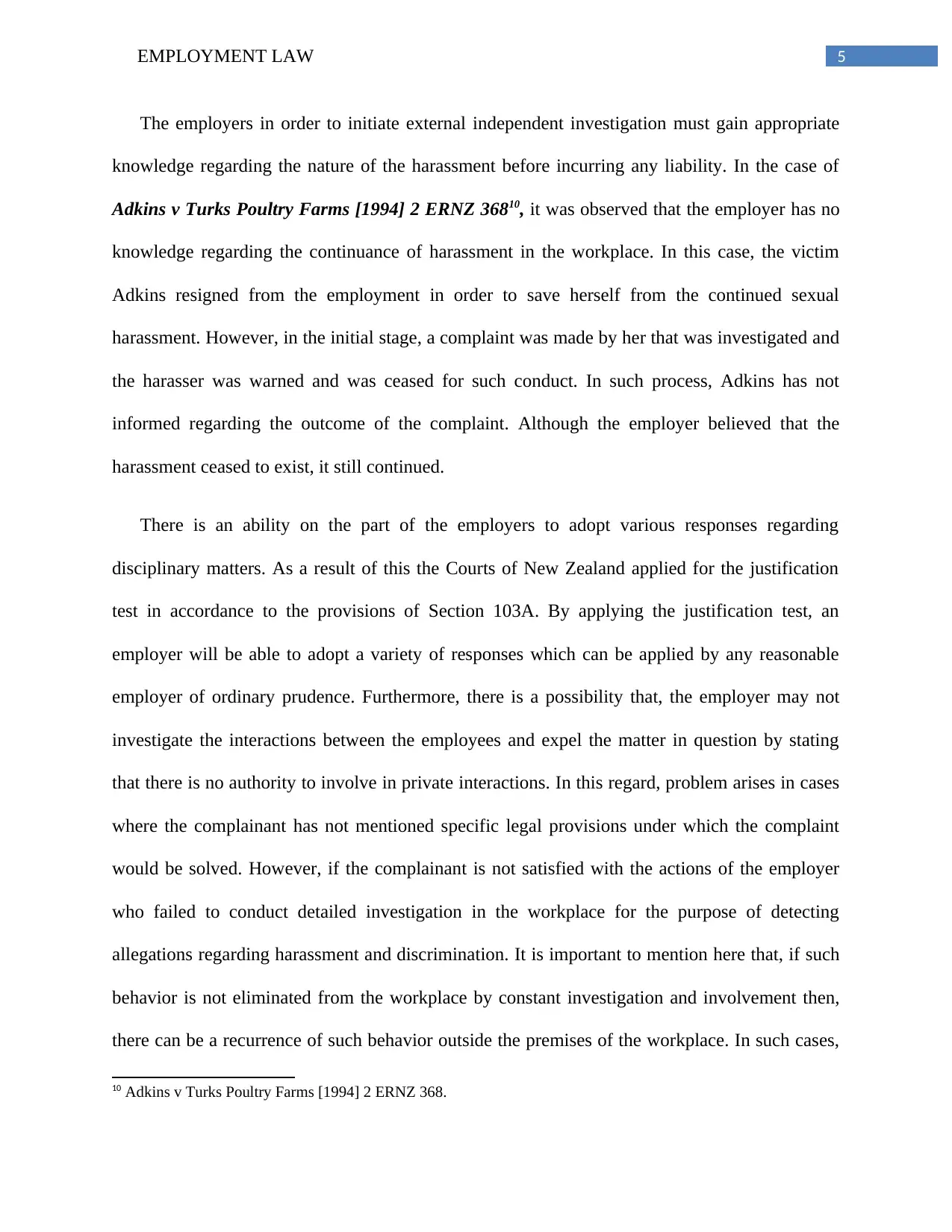
5EMPLOYMENT LAW
The employers in order to initiate external independent investigation must gain appropriate
knowledge regarding the nature of the harassment before incurring any liability. In the case of
Adkins v Turks Poultry Farms [1994] 2 ERNZ 36810, it was observed that the employer has no
knowledge regarding the continuance of harassment in the workplace. In this case, the victim
Adkins resigned from the employment in order to save herself from the continued sexual
harassment. However, in the initial stage, a complaint was made by her that was investigated and
the harasser was warned and was ceased for such conduct. In such process, Adkins has not
informed regarding the outcome of the complaint. Although the employer believed that the
harassment ceased to exist, it still continued.
There is an ability on the part of the employers to adopt various responses regarding
disciplinary matters. As a result of this the Courts of New Zealand applied for the justification
test in accordance to the provisions of Section 103A. By applying the justification test, an
employer will be able to adopt a variety of responses which can be applied by any reasonable
employer of ordinary prudence. Furthermore, there is a possibility that, the employer may not
investigate the interactions between the employees and expel the matter in question by stating
that there is no authority to involve in private interactions. In this regard, problem arises in cases
where the complainant has not mentioned specific legal provisions under which the complaint
would be solved. However, if the complainant is not satisfied with the actions of the employer
who failed to conduct detailed investigation in the workplace for the purpose of detecting
allegations regarding harassment and discrimination. It is important to mention here that, if such
behavior is not eliminated from the workplace by constant investigation and involvement then,
there can be a recurrence of such behavior outside the premises of the workplace. In such cases,
10 Adkins v Turks Poultry Farms [1994] 2 ERNZ 368.
The employers in order to initiate external independent investigation must gain appropriate
knowledge regarding the nature of the harassment before incurring any liability. In the case of
Adkins v Turks Poultry Farms [1994] 2 ERNZ 36810, it was observed that the employer has no
knowledge regarding the continuance of harassment in the workplace. In this case, the victim
Adkins resigned from the employment in order to save herself from the continued sexual
harassment. However, in the initial stage, a complaint was made by her that was investigated and
the harasser was warned and was ceased for such conduct. In such process, Adkins has not
informed regarding the outcome of the complaint. Although the employer believed that the
harassment ceased to exist, it still continued.
There is an ability on the part of the employers to adopt various responses regarding
disciplinary matters. As a result of this the Courts of New Zealand applied for the justification
test in accordance to the provisions of Section 103A. By applying the justification test, an
employer will be able to adopt a variety of responses which can be applied by any reasonable
employer of ordinary prudence. Furthermore, there is a possibility that, the employer may not
investigate the interactions between the employees and expel the matter in question by stating
that there is no authority to involve in private interactions. In this regard, problem arises in cases
where the complainant has not mentioned specific legal provisions under which the complaint
would be solved. However, if the complainant is not satisfied with the actions of the employer
who failed to conduct detailed investigation in the workplace for the purpose of detecting
allegations regarding harassment and discrimination. It is important to mention here that, if such
behavior is not eliminated from the workplace by constant investigation and involvement then,
there can be a recurrence of such behavior outside the premises of the workplace. In such cases,
10 Adkins v Turks Poultry Farms [1994] 2 ERNZ 368.
⊘ This is a preview!⊘
Do you want full access?
Subscribe today to unlock all pages.

Trusted by 1+ million students worldwide
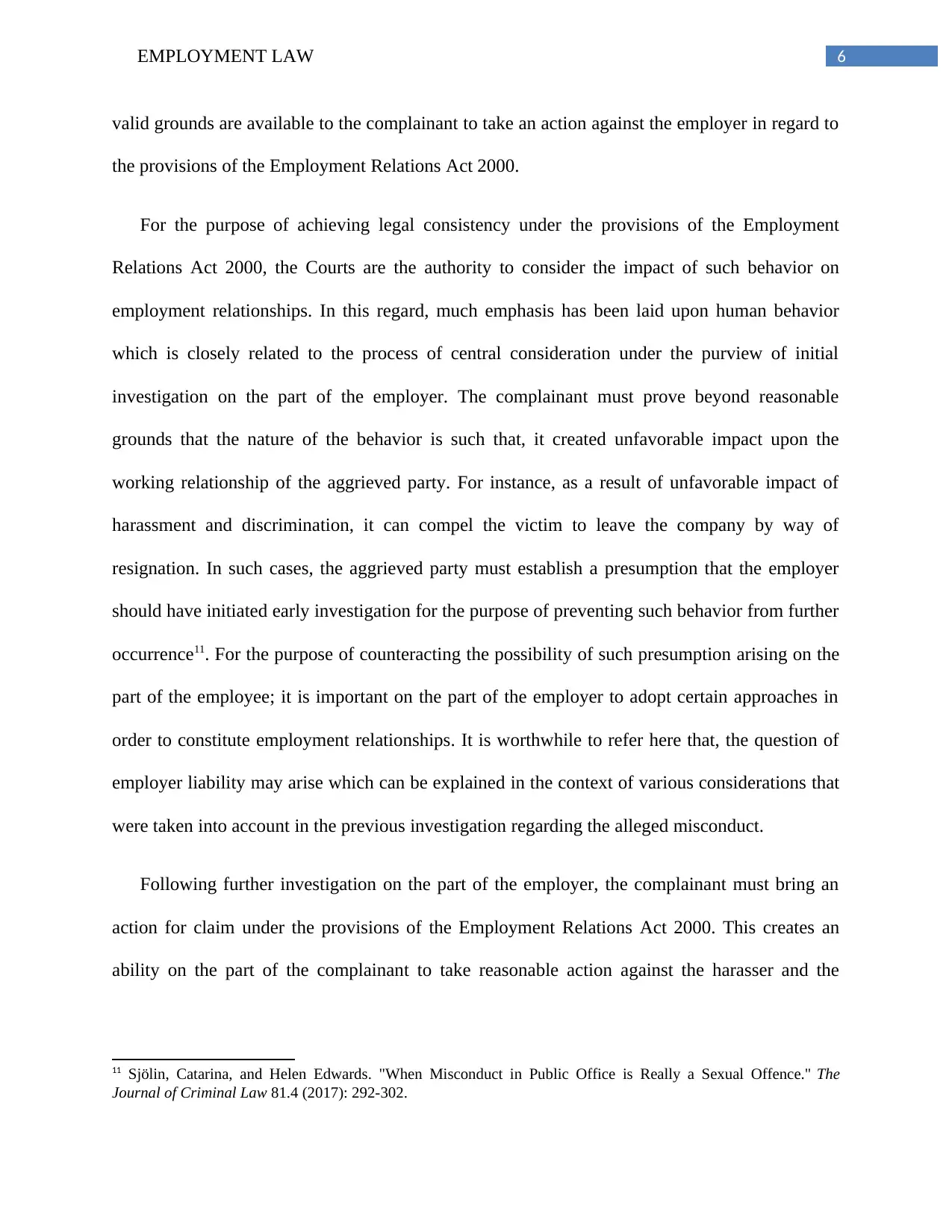
6EMPLOYMENT LAW
valid grounds are available to the complainant to take an action against the employer in regard to
the provisions of the Employment Relations Act 2000.
For the purpose of achieving legal consistency under the provisions of the Employment
Relations Act 2000, the Courts are the authority to consider the impact of such behavior on
employment relationships. In this regard, much emphasis has been laid upon human behavior
which is closely related to the process of central consideration under the purview of initial
investigation on the part of the employer. The complainant must prove beyond reasonable
grounds that the nature of the behavior is such that, it created unfavorable impact upon the
working relationship of the aggrieved party. For instance, as a result of unfavorable impact of
harassment and discrimination, it can compel the victim to leave the company by way of
resignation. In such cases, the aggrieved party must establish a presumption that the employer
should have initiated early investigation for the purpose of preventing such behavior from further
occurrence11. For the purpose of counteracting the possibility of such presumption arising on the
part of the employee; it is important on the part of the employer to adopt certain approaches in
order to constitute employment relationships. It is worthwhile to refer here that, the question of
employer liability may arise which can be explained in the context of various considerations that
were taken into account in the previous investigation regarding the alleged misconduct.
Following further investigation on the part of the employer, the complainant must bring an
action for claim under the provisions of the Employment Relations Act 2000. This creates an
ability on the part of the complainant to take reasonable action against the harasser and the
11 Sjölin, Catarina, and Helen Edwards. "When Misconduct in Public Office is Really a Sexual Offence." The
Journal of Criminal Law 81.4 (2017): 292-302.
valid grounds are available to the complainant to take an action against the employer in regard to
the provisions of the Employment Relations Act 2000.
For the purpose of achieving legal consistency under the provisions of the Employment
Relations Act 2000, the Courts are the authority to consider the impact of such behavior on
employment relationships. In this regard, much emphasis has been laid upon human behavior
which is closely related to the process of central consideration under the purview of initial
investigation on the part of the employer. The complainant must prove beyond reasonable
grounds that the nature of the behavior is such that, it created unfavorable impact upon the
working relationship of the aggrieved party. For instance, as a result of unfavorable impact of
harassment and discrimination, it can compel the victim to leave the company by way of
resignation. In such cases, the aggrieved party must establish a presumption that the employer
should have initiated early investigation for the purpose of preventing such behavior from further
occurrence11. For the purpose of counteracting the possibility of such presumption arising on the
part of the employee; it is important on the part of the employer to adopt certain approaches in
order to constitute employment relationships. It is worthwhile to refer here that, the question of
employer liability may arise which can be explained in the context of various considerations that
were taken into account in the previous investigation regarding the alleged misconduct.
Following further investigation on the part of the employer, the complainant must bring an
action for claim under the provisions of the Employment Relations Act 2000. This creates an
ability on the part of the complainant to take reasonable action against the harasser and the
11 Sjölin, Catarina, and Helen Edwards. "When Misconduct in Public Office is Really a Sexual Offence." The
Journal of Criminal Law 81.4 (2017): 292-302.
Paraphrase This Document
Need a fresh take? Get an instant paraphrase of this document with our AI Paraphraser
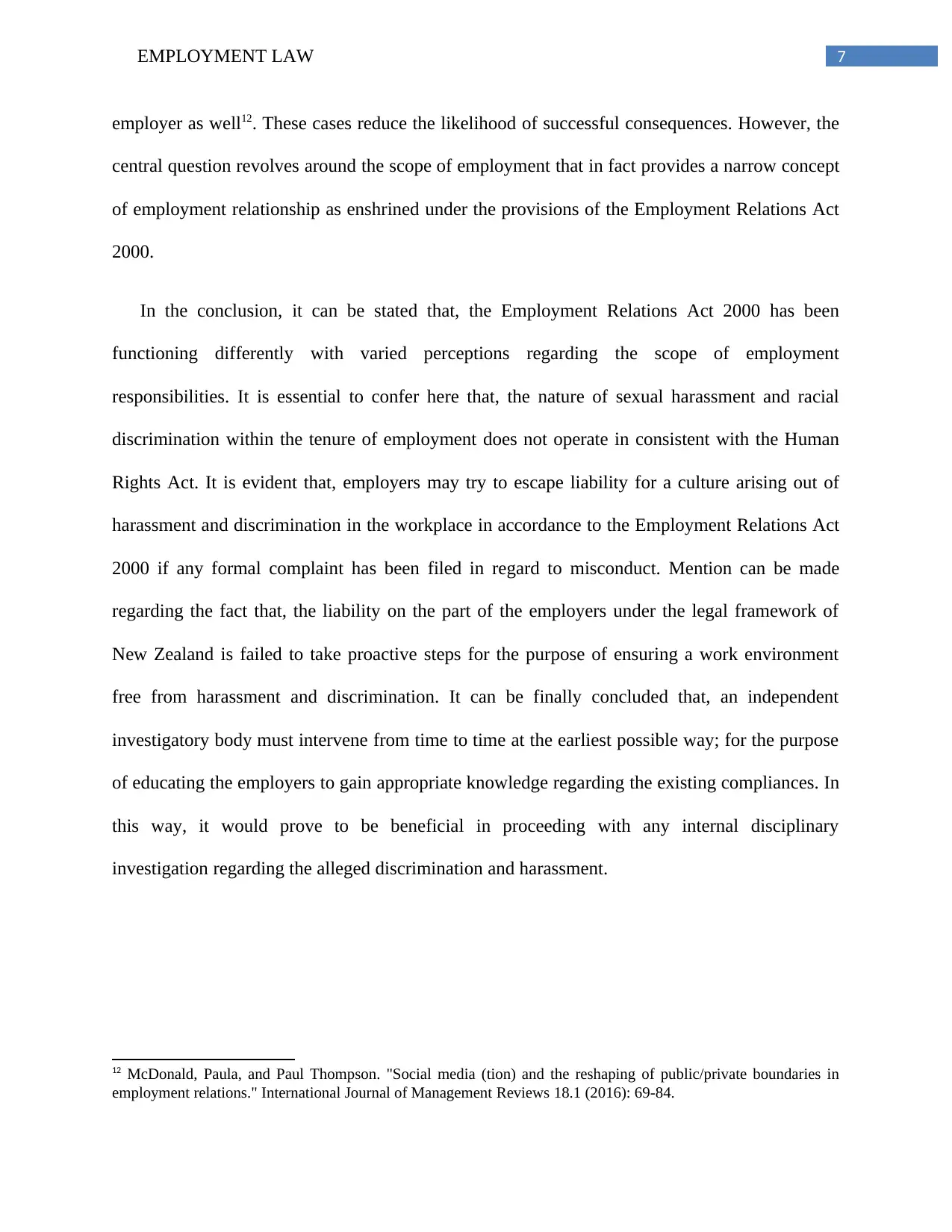
7EMPLOYMENT LAW
employer as well12. These cases reduce the likelihood of successful consequences. However, the
central question revolves around the scope of employment that in fact provides a narrow concept
of employment relationship as enshrined under the provisions of the Employment Relations Act
2000.
In the conclusion, it can be stated that, the Employment Relations Act 2000 has been
functioning differently with varied perceptions regarding the scope of employment
responsibilities. It is essential to confer here that, the nature of sexual harassment and racial
discrimination within the tenure of employment does not operate in consistent with the Human
Rights Act. It is evident that, employers may try to escape liability for a culture arising out of
harassment and discrimination in the workplace in accordance to the Employment Relations Act
2000 if any formal complaint has been filed in regard to misconduct. Mention can be made
regarding the fact that, the liability on the part of the employers under the legal framework of
New Zealand is failed to take proactive steps for the purpose of ensuring a work environment
free from harassment and discrimination. It can be finally concluded that, an independent
investigatory body must intervene from time to time at the earliest possible way; for the purpose
of educating the employers to gain appropriate knowledge regarding the existing compliances. In
this way, it would prove to be beneficial in proceeding with any internal disciplinary
investigation regarding the alleged discrimination and harassment.
12 McDonald, Paula, and Paul Thompson. "Social media (tion) and the reshaping of public/private boundaries in
employment relations." International Journal of Management Reviews 18.1 (2016): 69-84.
employer as well12. These cases reduce the likelihood of successful consequences. However, the
central question revolves around the scope of employment that in fact provides a narrow concept
of employment relationship as enshrined under the provisions of the Employment Relations Act
2000.
In the conclusion, it can be stated that, the Employment Relations Act 2000 has been
functioning differently with varied perceptions regarding the scope of employment
responsibilities. It is essential to confer here that, the nature of sexual harassment and racial
discrimination within the tenure of employment does not operate in consistent with the Human
Rights Act. It is evident that, employers may try to escape liability for a culture arising out of
harassment and discrimination in the workplace in accordance to the Employment Relations Act
2000 if any formal complaint has been filed in regard to misconduct. Mention can be made
regarding the fact that, the liability on the part of the employers under the legal framework of
New Zealand is failed to take proactive steps for the purpose of ensuring a work environment
free from harassment and discrimination. It can be finally concluded that, an independent
investigatory body must intervene from time to time at the earliest possible way; for the purpose
of educating the employers to gain appropriate knowledge regarding the existing compliances. In
this way, it would prove to be beneficial in proceeding with any internal disciplinary
investigation regarding the alleged discrimination and harassment.
12 McDonald, Paula, and Paul Thompson. "Social media (tion) and the reshaping of public/private boundaries in
employment relations." International Journal of Management Reviews 18.1 (2016): 69-84.
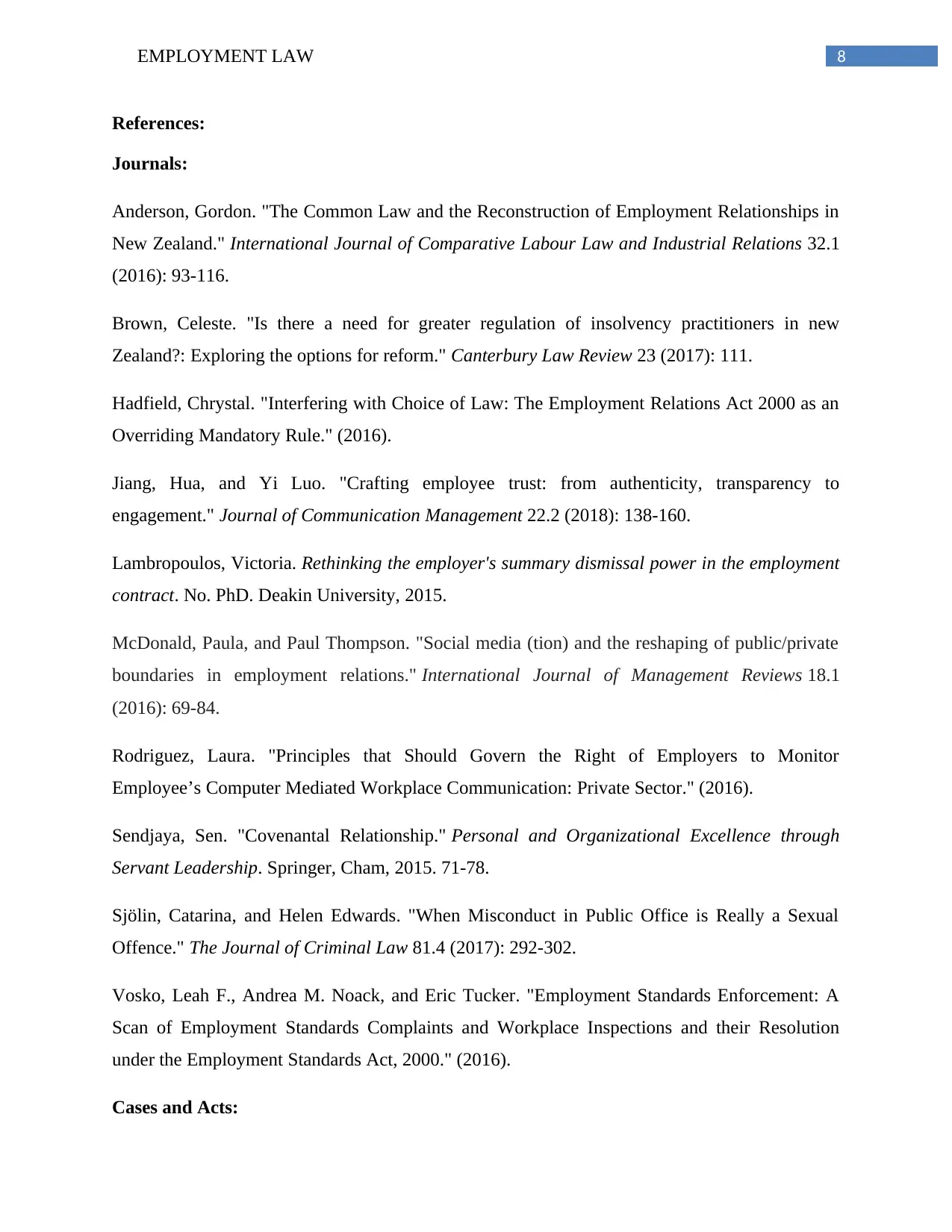
8EMPLOYMENT LAW
References:
Journals:
Anderson, Gordon. "The Common Law and the Reconstruction of Employment Relationships in
New Zealand." International Journal of Comparative Labour Law and Industrial Relations 32.1
(2016): 93-116.
Brown, Celeste. "Is there a need for greater regulation of insolvency practitioners in new
Zealand?: Exploring the options for reform." Canterbury Law Review 23 (2017): 111.
Hadfield, Chrystal. "Interfering with Choice of Law: The Employment Relations Act 2000 as an
Overriding Mandatory Rule." (2016).
Jiang, Hua, and Yi Luo. "Crafting employee trust: from authenticity, transparency to
engagement." Journal of Communication Management 22.2 (2018): 138-160.
Lambropoulos, Victoria. Rethinking the employer's summary dismissal power in the employment
contract. No. PhD. Deakin University, 2015.
McDonald, Paula, and Paul Thompson. "Social media (tion) and the reshaping of public/private
boundaries in employment relations." International Journal of Management Reviews 18.1
(2016): 69-84.
Rodriguez, Laura. "Principles that Should Govern the Right of Employers to Monitor
Employee’s Computer Mediated Workplace Communication: Private Sector." (2016).
Sendjaya, Sen. "Covenantal Relationship." Personal and Organizational Excellence through
Servant Leadership. Springer, Cham, 2015. 71-78.
Sjölin, Catarina, and Helen Edwards. "When Misconduct in Public Office is Really a Sexual
Offence." The Journal of Criminal Law 81.4 (2017): 292-302.
Vosko, Leah F., Andrea M. Noack, and Eric Tucker. "Employment Standards Enforcement: A
Scan of Employment Standards Complaints and Workplace Inspections and their Resolution
under the Employment Standards Act, 2000." (2016).
Cases and Acts:
References:
Journals:
Anderson, Gordon. "The Common Law and the Reconstruction of Employment Relationships in
New Zealand." International Journal of Comparative Labour Law and Industrial Relations 32.1
(2016): 93-116.
Brown, Celeste. "Is there a need for greater regulation of insolvency practitioners in new
Zealand?: Exploring the options for reform." Canterbury Law Review 23 (2017): 111.
Hadfield, Chrystal. "Interfering with Choice of Law: The Employment Relations Act 2000 as an
Overriding Mandatory Rule." (2016).
Jiang, Hua, and Yi Luo. "Crafting employee trust: from authenticity, transparency to
engagement." Journal of Communication Management 22.2 (2018): 138-160.
Lambropoulos, Victoria. Rethinking the employer's summary dismissal power in the employment
contract. No. PhD. Deakin University, 2015.
McDonald, Paula, and Paul Thompson. "Social media (tion) and the reshaping of public/private
boundaries in employment relations." International Journal of Management Reviews 18.1
(2016): 69-84.
Rodriguez, Laura. "Principles that Should Govern the Right of Employers to Monitor
Employee’s Computer Mediated Workplace Communication: Private Sector." (2016).
Sendjaya, Sen. "Covenantal Relationship." Personal and Organizational Excellence through
Servant Leadership. Springer, Cham, 2015. 71-78.
Sjölin, Catarina, and Helen Edwards. "When Misconduct in Public Office is Really a Sexual
Offence." The Journal of Criminal Law 81.4 (2017): 292-302.
Vosko, Leah F., Andrea M. Noack, and Eric Tucker. "Employment Standards Enforcement: A
Scan of Employment Standards Complaints and Workplace Inspections and their Resolution
under the Employment Standards Act, 2000." (2016).
Cases and Acts:
⊘ This is a preview!⊘
Do you want full access?
Subscribe today to unlock all pages.

Trusted by 1+ million students worldwide
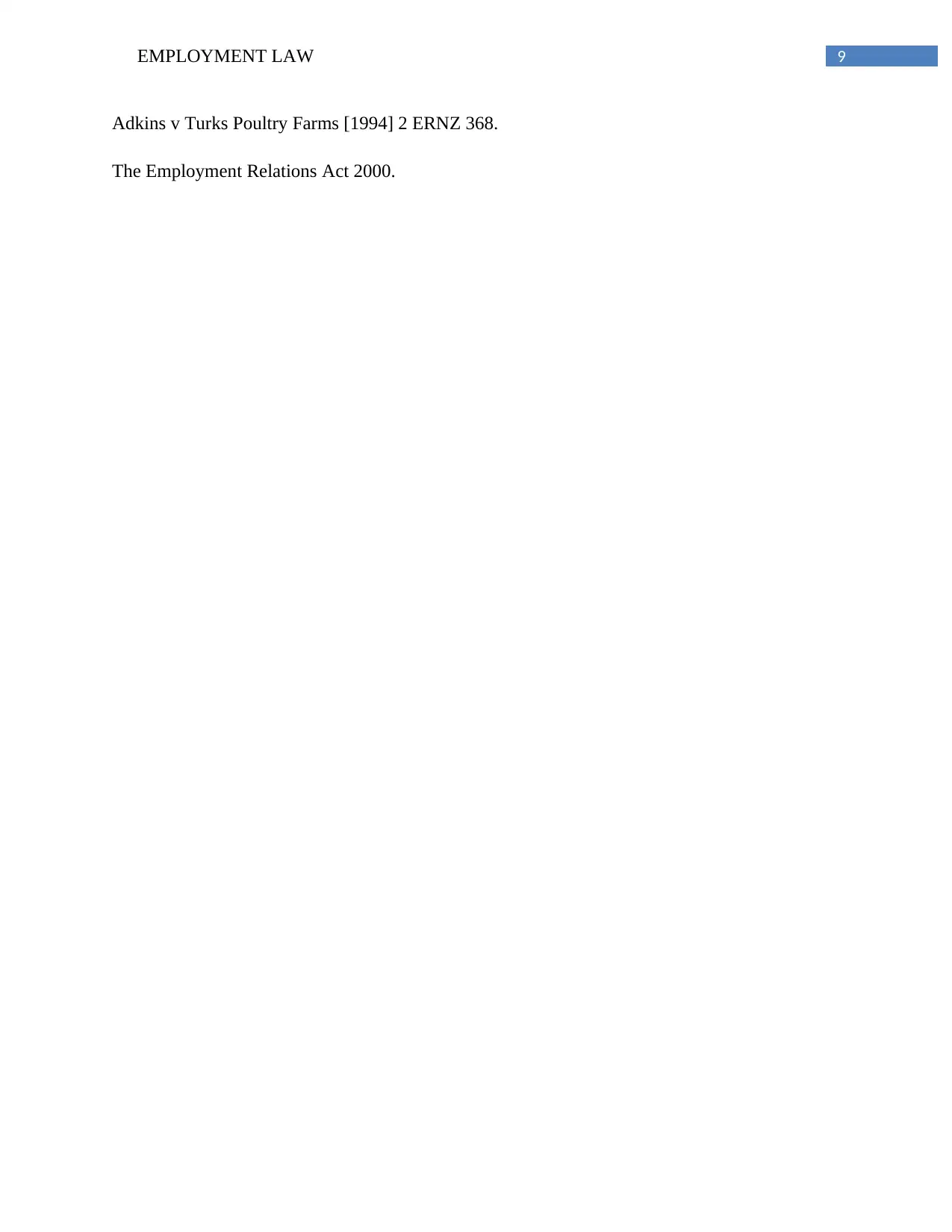
9EMPLOYMENT LAW
Adkins v Turks Poultry Farms [1994] 2 ERNZ 368.
The Employment Relations Act 2000.
Adkins v Turks Poultry Farms [1994] 2 ERNZ 368.
The Employment Relations Act 2000.
1 out of 10
Your All-in-One AI-Powered Toolkit for Academic Success.
+13062052269
info@desklib.com
Available 24*7 on WhatsApp / Email
![[object Object]](/_next/static/media/star-bottom.7253800d.svg)
Unlock your academic potential
Copyright © 2020–2025 A2Z Services. All Rights Reserved. Developed and managed by ZUCOL.
